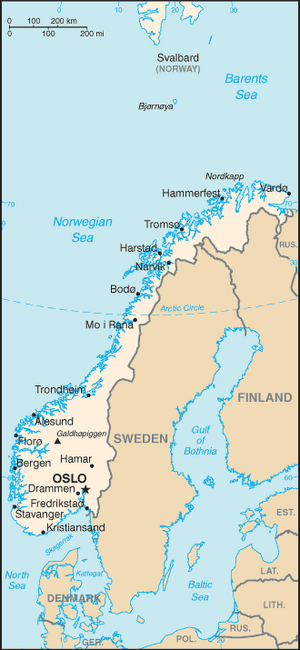Plan R 4 facts for kids
Plan R 4 was a secret plan by the British government during World War II. It was made in April 1940. The plan was to invade parts of Norway and Sweden.
However, this plan never actually happened. This was because Germany launched its own invasion of Norway at the same time. Similar ideas had been considered earlier during the Winter War.
Contents
Why the Plan Was Made
Germany did not have enough iron ore on its own. Iron ore is a key material used to make steel. Steel is needed for tanks, guns, ships, and other war machines. Before the war, Germany got a lot of iron from France. But after September 1939, this supply stopped.
So, Germany relied heavily on iron ore from Sweden. This ore was vital for their war factories.
Shipping Iron Ore
In the summer, Swedish iron ore was shipped from the port of Luleå. Luleå is in the northern part of the Baltic Sea. But in winter, the sea freezes. So, for several months, most of the ore went by train. It traveled through Norway to the port of Narvik. Narvik is in the far north and does not freeze.
About 80% of Sweden's iron ore was shipped through Narvik in winter. Ships from Narvik traveled mostly through Norwegian waters. This made them safe from British attacks. Britain wanted to stop these shipments. This would hurt Germany's ability to make weapons.

(Borders shown are from 1920 to 1940.)
Allied Plans for Finland
The Allies (Britain and France) came up with a plan. They would use the Soviet Union's attack on Finland in November 1939 as an excuse. Their real goal was to seize Swedish iron ore fields and Norwegian ports.
The plan was to ask Norway and Sweden for permission. They would send troops through these countries to help Finland. Once there, the troops would take control of Swedish mines and ports. They would also occupy cities like Gävle and Luleå. This would stop Germany from getting Swedish ore. This move would surprise Norway and Sweden.
However, both Sweden and Norway refused. They did not want their countries to become a battlefield. They also feared being occupied by either side.
Germany's Response
Meanwhile, Germany realized the Allies might try something. They began planning their own invasion of Norway. This was to protect their important supply routes. The Altmark Incident in February 1940 made Adolf Hitler sure. He believed the Allies would not respect Norway's neutrality. So, he ordered his invasion plans to be sped up.
The Nordic countries did not want Allied troops. This stopped the original Allied plan. But on March 12, the Allies decided to try a "semi-peaceful" invasion. Troops would land in Norway and move into Sweden to capture the mines. If they met strong resistance, they would not push forward. However, Finland made peace on March 13. So, this new plan was also dropped.
Germany knew some of the Allied plans. They intercepted radio messages. These showed Allied ships were ready. Later messages said the Allies had given up the plan. But Hitler still worried. He feared the Allies would invade sooner or later. So, April 9 was set for Operation Weserübung. This was Germany's attack on both Denmark and Norway.
The Plan Details
Britain had two separate plans working together: Operation Wilfred and Plan R 4.
Operation Wilfred
Operation Wilfred was a British navy plan. It was supposed to start on April 5, but was delayed to April 8. The goal was to place two mine fields in Norwegian waters. This would force ore ships into international waters. There, the Royal Navy could easily stop them. This would prevent Swedish iron ore from reaching Germany. Norway and Sweden were to be told beforehand. They would be accused of not being able to stay neutral.
Plan R 4
Plan R 4 had several parts:
- Stratford – This was the main British force. It included Scots Guards and anti-aircraft units. Their job was to take the area from Narvik to the Swedish border, following the railway.
- Avonmouth – This was a combined British and French force. They would attack the Sola airfield near Stavanger. They would also occupy Bergen and Trondheim. This force included British infantry and a French Alpine brigade.
- Plymouth – This was a British force. It would land at Trondheim and move east.
The plan hoped that Operation Wilfred would make Germany react. If Germany landed troops in Norway, or threatened to, Plan R 4 would begin. The first troop ships would sail just hours after the mines were laid.
The orders stated that no troops would land in Norway until Germany broke Norway's neutrality. Or, there had to be clear proof that Germany intended to do so. Both plans assumed that the Norwegians would not fight against the British forces.
What Happened Next
Plan R 4 could not be carried out as planned. Major parts of the German navy were seen in Norwegian waters. But Allied troops were quickly sent to Norway. They fought alongside the Norwegians.
The Allies had some success against the Germans in the Narvik area. They almost made the Germans surrender there. The Allied forces included 24,500 British, Norwegian, French, and Polish troops. These included marines, French Foreign Legionnaires, and Polish mountain troops. The German forces had 2,000 mountain troops and 2,600 sailors. These sailors were from German ships that had been sunk.
On April 17, 1940, Hitler ordered his troops to leave for Sweden. They were to be held there. However, Germany then had a very successful campaign against France and other countries. This led the Allies to move their troops away from Norway. Allied troops left Narvik by June 8, 1940.
See also
- Franco-British plans for intervention in the Winter War
- Foreign support in the Winter War
- British occupation of the Faroe Islands in World War II
- Iceland during World War II
- Project Catherine


